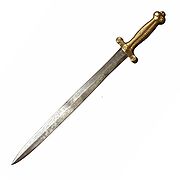
Fascine knife
Encyclopedia

Side arm
A side arm is a weapon, usually a pistol but can be a dagger, as used in pre-modern times, which is worn on the body in a holster to permit immediate access and use. A side arm is typically required equipment for military personnel and sometimes carried by law enforcement personnel...
/ tool
Tool
A tool is a device that can be used to produce an item or achieve a task, but that is not consumed in the process. Informally the word is also used to describe a procedure or process with a specific purpose. Tools that are used in particular fields or activities may have different designations such...
issued to 17th to 19th century light infantry
Light infantry
Traditionally light infantry were soldiers whose job was to provide a skirmishing screen ahead of the main body of infantry, harassing and delaying the enemy advance. Light infantry was distinct from medium, heavy or line infantry. Heavy infantry were dedicated primarily to fighting in tight...
and artillery
Artillery
Originally applied to any group of infantry primarily armed with projectile weapons, artillery has over time become limited in meaning to refer only to those engines of war that operate by projection of munitions far beyond the range of effect of personal weapons...
. It served both as a personal weapon and as a tool for cutting fascine
Fascine
A fascine is a rough bundle of brushwood used for strengthening an earthen structure, or making a path across uneven or wet terrain. Typical uses are protecting the banks of streams from erosion, covering marshy ground and so on.-Early military use:...
s (bundles of sticks used to strengthen the sides of trenches or earth ramparts
Defensive wall
A defensive wall is a fortification used to protect a city or settlement from potential aggressors. In ancient to modern times, they were used to enclose settlements...
protecting the batteries
Artillery battery
In military organizations, an artillery battery is a unit of guns, mortars, rockets or missiles so grouped in order to facilitate better battlefield communication and command and control, as well as to provide dispersion for its constituent gunnery crews and their systems...
). It could be straight or curved, double edged or single edged with a sawtoothed back. 17th and 18th century German, Prussian and Swedish fascine knives are more like cavalry swords, often with a brass handle and a hand guard, but later models are more like billhook
Billhook
The billhook is a traditional cutting tool known and used throughout the world, and very common in the wine-growing countries of Europe, used widely in agriculture and forestry The billhook (also bill hook – although this more usually refers to either a metal or plastic hook used to hold bills,...
s in shape and appearance. By the 20th century in the British Army it had become the Pioneer's billhook, used in World War I for making machine gun emplacements. In the Indian Army it is known as a Knife Gabion (gabion
Gabion
Gabions are cages, cylinders, or boxes filled with soil or sand that are used in civil engineering, road building, and military applications. For erosion control caged riprap is used. For dams or foundation construction, cylindrical metal structures are used...
s, like fascines, are used for supporting earthworks).
Some types of fascine knife are probably descended from 16th century sidearms weapons like the baselard
Baselard
The baselard is a historical type of dagger or short sword of the Late Middle Ages.In modern use by antiquarians, the term baselard is mostly reserved for a type of 14th...
or the Swiss sword
Swiss sword
Swiss sword can refer to:*the Swiss degen*the broadsword used by the Swiss, see walloon sword*the Swiss sabre...
. Others, known to British
British Army
The British Army is the land warfare branch of Her Majesty's Armed Forces in the United Kingdom. It came into being with the unification of the Kingdom of England and Scotland into the Kingdom of Great Britain in 1707. The new British Army incorporated Regiments that had already existed in England...
foot soldiers as a billhook, are more closely related to agricultural cutting tools.
Like the billhook they were used for cutting saplings (e.g. willow, hazel or chestnut) that were bundled up to make fascines or woven into hurdles, or gabions. Many revetments used a combination of all three, with fascines at the bottom of the trench, hurdles just below ground level and gabions above, filled with the earth from the trench.
Although the Spanish Army
Spanish Army
The Spanish Army is the terrestrial army of the Spanish Armed Forces responsible for land-based military operations. It is one of the oldest active armies - dating back to the 15th century.-Introduction:...
called its fascine knives machete
Machete
The machete is a large cleaver-like cutting tool. The blade is typically long and usually under thick. In the English language, an equivalent term is matchet, though it is less commonly known...
s, they bore little resemblance to the common cutting tool.

